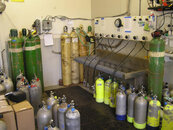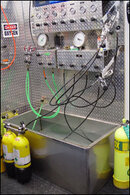TN-Steve
Contributor
Hey gang,
The shop owner where I work want's to put some type of a containment system in place at the fill station. I'm thinking of something like a large wooden box full of sand, with individual sleeves for the tanks to slip into vertically. The sand layer would be tall enough to come to the neck of a HP 120, probably some inserts to let 80's sit nicely.
The idea would be that in the unlikely event of a tank letting go, the sand would act to tamp the forces, and direct most of it upward, where it not going to damage anything more important than the metal roof over the fill station.
I'm drawing a blank finding any good info out there, how much sand to have around each tank, things like that. I'm confident enough in my wood butchery that I can build a structure capable of handling the weight of the sand, so that's not a concern. I just don't have a clue how much sand would be required to be effective, or if there are more effective designs I could take advantage of.
Any suggestions, ideas or recommendations. Bonus points (redeemable for kittens at the end of the year) will be given for real life experience or working links to people who have documented designs on the web.
Thank in Advance,
Steve
The shop owner where I work want's to put some type of a containment system in place at the fill station. I'm thinking of something like a large wooden box full of sand, with individual sleeves for the tanks to slip into vertically. The sand layer would be tall enough to come to the neck of a HP 120, probably some inserts to let 80's sit nicely.
The idea would be that in the unlikely event of a tank letting go, the sand would act to tamp the forces, and direct most of it upward, where it not going to damage anything more important than the metal roof over the fill station.
I'm drawing a blank finding any good info out there, how much sand to have around each tank, things like that. I'm confident enough in my wood butchery that I can build a structure capable of handling the weight of the sand, so that's not a concern. I just don't have a clue how much sand would be required to be effective, or if there are more effective designs I could take advantage of.
Any suggestions, ideas or recommendations. Bonus points (redeemable for kittens at the end of the year) will be given for real life experience or working links to people who have documented designs on the web.
Thank in Advance,
Steve






